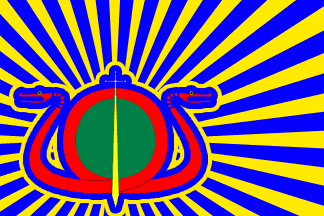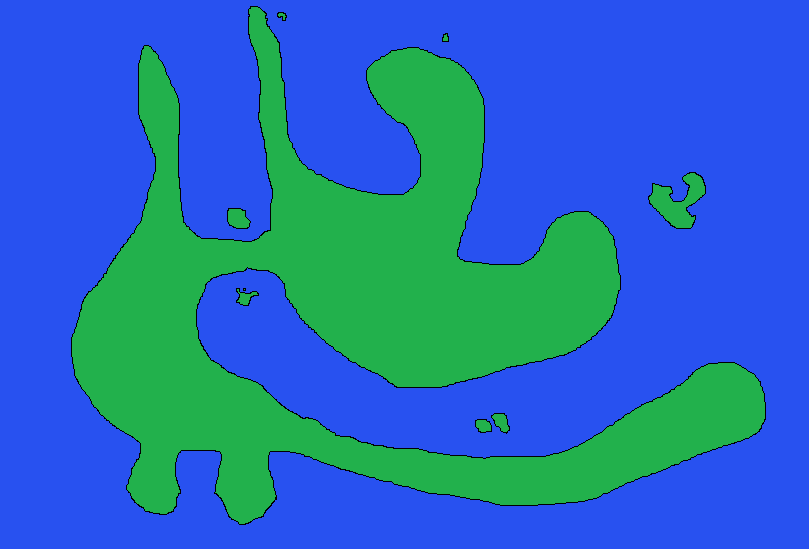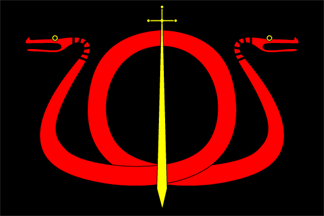National Symbols

This is the most common flag in use in the Archipelago. It was established at the foundation, when its meaning was also dictated for future generations.
The blue stands for the sea and all of it's wonder. The serpent's heads represent our Navy, which defends us throughout the ages, while it's body represents the other valiant defenders of our islands. The sword stands for our rapid expansionism, and the green represents the islands in our defence.
This is the Imperial flag, used as the national flag since 2625. It was established when the Imperial government was instated at that time. The meaning of the more common flag above applies to this, with one addition.
The golden beams represent the intelligence and wealth our Empire brings to the islands it gathers.

This is the personal flag of the Imperial Family. The purple replacing the blue beams represents royalty and monarchy.

Carcharodon Megalodon, seen here attacking a pod of sperm whales, is the national animal of the Archipelago, chosen because it resembles the Navy with it's sheer size and power. They can be seen everywhere in the Archipelago, and a growing minority have gained intelligence.

The Peacock, which is very prevalent in the Archipelago, was chosen as the national bird for it's striking plumage, which some say is reminiscent of the national flag. For years, the leader of the nation wore peacock feathers as a cape.

The Giant Isopod was chosen as the national insect-like thing officially because it was first discovered by our first deep sea exploration expedition in the mid 2300s, but actually because no actual insect fit our nation.

The Oceanic Ring flower was chosen as the national flower for it's prevalence in the area where the capital, Adiakav, was first constructed. As with the national bird, some believe it resembles the national flag.

This is the National Seal, used since the last days of socialist rule. Because it did not contain any blatant signs of socialism, it was kept after the imperial transition.
Geography
Oceaniya is a tropical world, having dense jungles going farther north and south from it's equator than Earth. The Archipelago is located on and slightly north of the equator. Most Vakiadian islands are tropical, the densest one Xiliki, the medium sized island carrying the capital city of Adiakav.

This is the average view of the non-urban areas of the islands, which are densely forested with many exotic plants and animals.
The island of Xiliki has a diameter of about 70,000 square miles, which is slightly larger than the average size of the islands. Xiliki is home to massive swathes of jungle and white, sandy beaches.
The capital city, Adiakav, rests on a thin area on the island of Xiliki. It has a population of 82.7 million. Due to this large and ever-growing population, the majority of Residential Districts are built on the sea, as seen here:

These floating towns can currently hold up to 750,000 people at a time.
Alongside these recent population surges, the first residential districts, built on land, are still in use. The Residential Districts on land are known for their massive skyscrapers and crowded, yet pristine, beaches.

A view of Residential District 3 from the coast. This area of the district lacks beaches, however most coastlines have them in abundance.
Adiakav is divided into 24 districts, all serving specific purposes. Residential Districts serve as living areas, and most are made up of some of the above floating towns. Merchant Districts are havens for those looking to sell their wares, and contain stock exchanges and factories. Entertainment Districts are filled to the brim with taverns and sports arenas of every imaginable kind. The singular Imperial District is where government officials live and carry out their duties. The Natural Districts usually consist of parks and zoos, but two of the five natural districts are completely underwater. The Starport Districts are the most recent additions, and ferry people and goods to and from the lunar and interplanetary colonies. The Imperial, first two Residential, first Entertainment and first Merchant were constructed out of the wreckage of the colony ships that crashed and deposited the survivors onto Oceaniya, where they began the long process of building a nation. Truly, Adiakav is a symbol of the nation.
A full breakdown of the districts is as follows:
Merchant District 1-4
Residential District 1-10
Entertainment District 1-2
Imperial District
Natural District 1-5
Starport District 1-2
Space Program & Solar System
Since 2649, colonies have existed on an otherworldly entity. In the years following, more colonies were formed on more moons and planets. As of writing, colonies exist on Hydrox, Syerr, Tiyansol, Mersilok, and Ristafol. Every celestial body colonized so far have brought forth new materials, abundances of materials rare on Oceaniya, and new life forms. The groups behind these monumental achievements are the Vakiadi Agency of Galactic Exploration (VAGE I) and the Vakiadi Academy of Galactic Expansion (VAGE II). VAGE I focuses primarily on galactic mapping and finding habitable planets, while VAGE II focuses on space military action and colony building. VAGE I has found a planet in another solar system giving off radio waves. This planet is also conveniently within the Goldilocks Zone of its parent star, named Dinani. The planet is named Slikina, and has one moon, Kylaska, from which radio signals were also recorded.
Currently, colonial progress is growing faster than ever, as Okolinu joins the ranks of colonized planets. So far, colonized planets include:
There are three planets currently not colonized in our solar system, since Kraspenil was colonized in 2672. The full list of these planets includes:
Government & Economy
The Imperial Archipelagic Planet, as noted by its name, is an Empire ruled by a monarchy since 2625. The Imperial Family currently consists of Supreme Imperial Master of the Vakiadian Archipelago (SIMVA) Imperier Nwerol and his brother, Imperial Prince Fyerian Nwerol. Imperier Nwerol is the third in what is expected to be a long line of rulers treading through the centuries. Supreme Imperial Mistress Syerra Mokidi, the wife of Tomastik Mokidi and mother of Tomaster Mokidi, still holds a ceremonial title, since she could not claim the throne after Tomaster Mokidi due to her paralysis. Other than the imperial family, there is an elected congress referred to as the Senate. Each island or small island group is represented here, along with all colonies. The citizens of an island are represented by their Senatorial, who vocalizes what he/she believes is best for their island. Each island has one Senatorial, elected through popular vote. The Senate as a whole makes domestic decisions, while the Imperial Family and 20 chosen Barons congregate on foreign issues. If the Barons and Imperial Family unanimously agreed the the Senate vote will not aid the nation in any way, the Senate ruling is overruled. The Barons also act as the Cabinet, providing advice to the Imperial Family and Supreme Imperial Master. The full list of Cabinet-related titles granted to the Barons (besides Baron) follow.
Imperial Minister of Defence
Imperial Minister of Finance & the Imperial Treasury
Imperial Minister of the Economy
Imperial Minister of National Affairs
Imperial Minister of Foreign Affairs
Imperial Minister of War
Imperial Minister of Industry
Imperial Minister of the Environment
Imperial Minister of Energy
Imperial Minister of Culture
Imperial Minister of Education
Imperial Minister of Technology
Imperial Minister of Commerce
Imperial Minister of Health
Imperial Minister of Intelligence
Imperial Minister of Transportation
Imperial Minister of Justice
Imperial Minister of Agriculture, Fisheries & Lumber
Imperial Minister of Resources
Imperial Minister of Labour

The senate building, currently able to hold all 753 Senatorials. All Senatorials sit on specially designed chairs across the spiral construction, with each island and island group receiving their own designated chair.
The economy is neither communist nor capitalist, and has attributes which go against both. The system is known as state capitalism. In the Vakiadian system, the mostly capitalist economy is controlled privately, but the government sets economic goals. These economic goals mostly decide what the government will need in the next 5-10 years. For instance, if there was a threat of revolt the plans would include weapons and vehicles. This economic style was implemented during the transition between socialist and imperial, for the purpose of preparation for an expected socialist revolt.



















